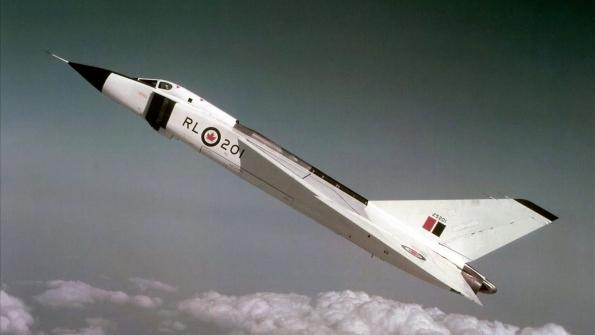1957: Broken Arrow

The cancellation of the Avro Canada CF-105 interceptor in February 1959 was a traumatic event for Canada's emerging aerospace industry. When Aviation Week reported on the fighter's rollout, in October 1957, the magazine called it "a serious contender for the top military aircraft of the next several years". High praise indeed, for a non-U.S. aircraft, given that the XB-58 supersonic bomber was in flight test and that new aircraft in the works included the A-5 Vigilante and the F-4 Phantom.

But the Arrow was extraordinary, and more so, given that the industry that produced it was less than a decade old when the prototype contract was issued in March 1955. Avro Canada had been formed by Britain's Hawker Siddeley Group after World War 2 and had quickly produced the CF-100 interceptor, the C-102 jet airliner (the world's second to fly), and the CF-100's Orenda engine, which was also fitted to Canadian-built Sabre fighters.
The CF-105 was a different kettle of fish entirely, designed to shoot down Soviet jet bombers over the Arctic, long before shorter-legged U.S. interceptors could touch them. Key requirements were a big radar, large missile load, long range and high speed, and agility at high speed and altitude. Translated: get out a long way quickly and accomplish multiple engagements before returning to refuel.
Chief designer Jim Floyd and his team produced a unique configuration, detailed in a 1958 lecture to the Royal Aeronautical Society. The delta wing was chosen for supersonic efficiency, and had a cambered and notched leading edge for better maneuverability. It was mounted on top of the fuselage (at the price of a complex landing gear) to gain the benefits of a continuous tip-to-tip structure and a simple fuselage design, with straight inlet ducts, easy engine access, and a large weapon bay. The missile bay was a drop-down pallet, offering the potential of interchangeable units for other missions.
The performance requirements meant that almost everything on the airplane had to be invented. No existing engine would do the job, so Avro spun off a new Orenda Engines subsidiary to produce the Iroquois, the most powerful supersonic engine of the 1950s. The airframe took Canada into the world of integrally machined skins, and both airframe and engine used titanium. The CF-105 was the first aircraft to use 4,000 psi hydraulics. Canada enlisted Hughes for help with the radar and missiles, but the radar was new and the missile was the active-homing Sparrow II. Management was a huge challenge, both because the aircraft was complex (the second-biggest Mach 2 airplane anywhere) and because of the program's sheer size: at its peak, Avro Canada was the nation's third-largest company and in the world Top 100.
Technically, it went quite well. The first four Arrows proved fast, even with interim J75 engines that delivered only three-quarters of the Iroquois' thrust: on the seventh test flight, the first CF-105 accelerated through 1,000 mph in a climb at 50,000 feet. By early 1959, the first Iroquois-powered Mk2 was in taxi tests.
Politically, the story was different. A new Progressive Conservative government had been elected in March 1957, sworn to rein in government spending. In June, Canada agreed to buy an extension of the U.S. Semi-Automatic Ground Environment air defense system and Boeing Bomarc missiles, further stressing the budget. Britain's infamous Defence White Paper of April 1957 declared that the Lightning would be the RAF's last manned fighter: the CF-105 had been seriously considered as its replacement. And despite the progress, there was a good deal of time and money left in the development program.
On February 20, 1959, prime minister John Diefenbaker announced the cancellation of the CF-105, and within two months almost all the hardware in the program had been destroyed and nearly 30,000 jobs eliminated.
The Arrow lived on in legends: Diefenbaker had scrapped the project under direct orders from Washington, which saw it as a threat to the U.S. industry; one of the prototypes had been spirited away before the wrecking crews arrived, and was hidden in Canada or in secret tests in the United States. Myths and reality have been the subject of more books and movies than many successful projects. As recently as 2012, the Canadian government -- bumbling its way through another fighter procurement -- was forced to deny that a neo-Arrow was a candidate to replace the F/A-18.
Would it have worked? The late Bill Gunston, technical editor of Flight in the 1950s and a shrewd reader of programs, believed that it would have done, particularly with British support (and the existence of Typhoon today shows how wrong the British government was in 1957). Even with the Soviet Union's backing away from strategic bombers in favor of missiles, the Arrow would have been very useful in Western Europe for defense against Tu-22M regional bombers. But none of that, unfortunately, was foreseen in 1959.
Note: Penultimate paragraph edited for clarity.
► Read the article from the October 21, 1957 issue of Aviation Week & Space Technology:
CF-105 Displays Advanced Engineering (part 1)
CF-105 Displays Advanced Engineering (part 2)
► Aviation Week is approaching its 100th anniversary in 2016. In a series of blogs, our editors highlight editorial content from the magazine's long and rich history, including viewpoints from the industry's most iconic names and stories that have helped change the shape of the industry.